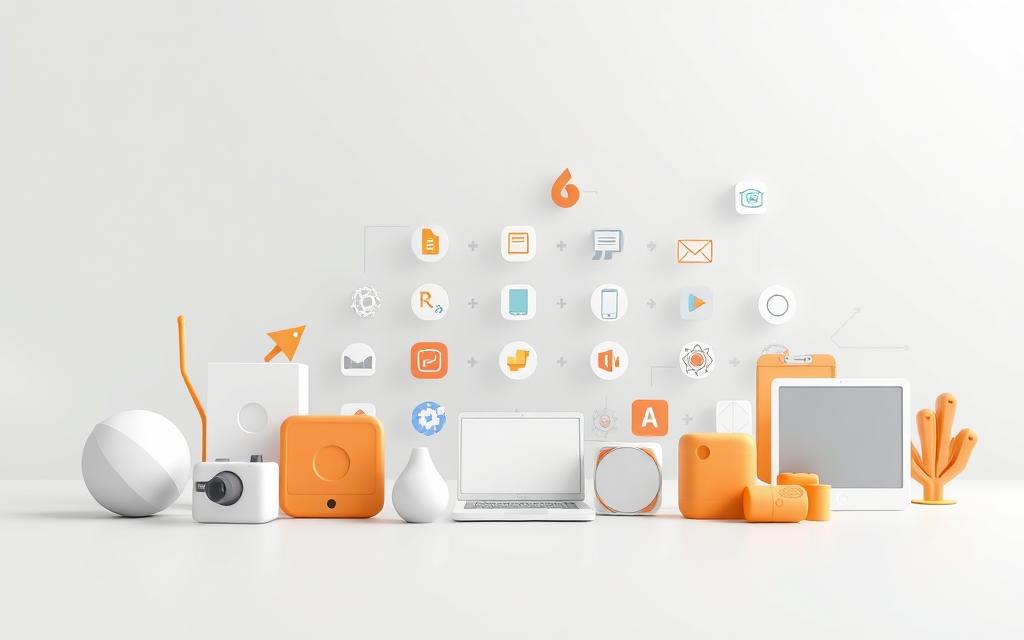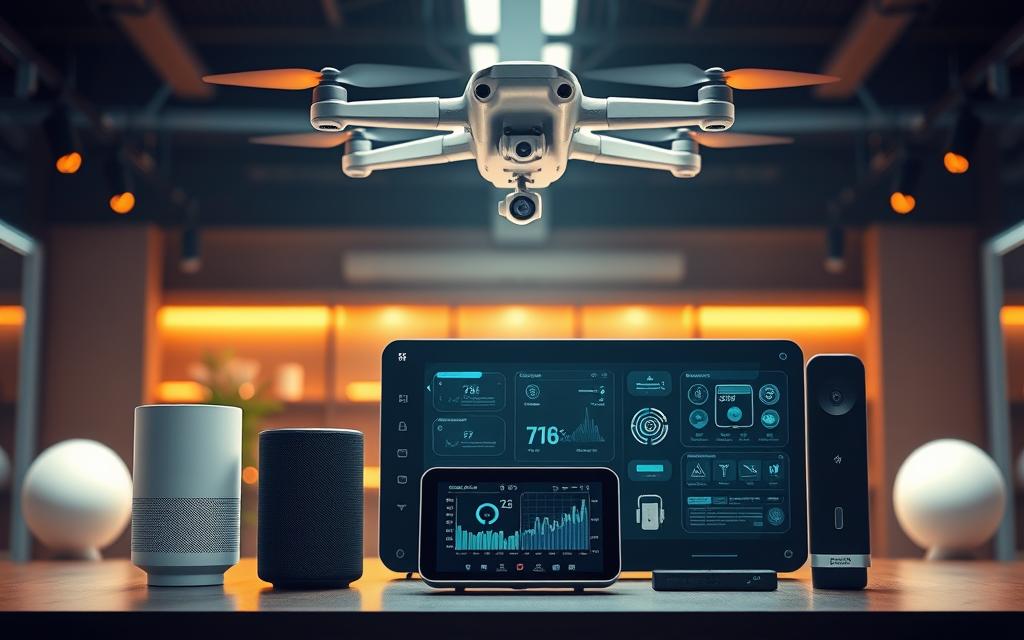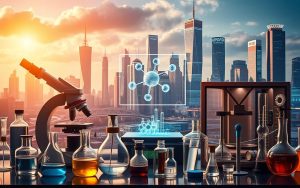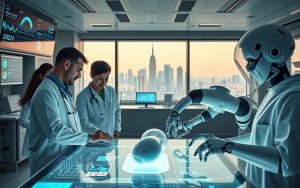In today’s digital world, defining a technology product is complex. The lines between software and hardware are now fuzzy. This change opens up new ways to innovate.
Technology products span a wide range. Some are just digital, like apps and cloud services. Others are physical, such as smartphones and industrial tools.
The most interesting things happen when these two meet. Companies like Tesla show how software can make hardware smarter. This mix brings great benefits to users.
For a product to succeed in tech, it must solve real problems. It doesn’t matter if it’s software, hardware, or both. What matters is how well it meets the user’s needs.
Defining a Technology Product
Today’s technology products mix physical parts with smart software. This mix lets them do complex tasks and change to meet user needs. They have both hardware and software parts that work together.
Hardware is the physical base of tech products. It includes things like processors and memory chips. The quality of these parts affects how well the product works and how happy users are.
Core Components and Value Proposition
Software is what makes hardware smart. It includes operating systems and apps that control how the parts work. This software layer lets users customise and update their products.
The value of tech products has changed a lot. Now, it’s not just about how they look or feel. It’s also about the software experience. Companies like Apple show this by focusing on the whole product experience, not just the hardware.
Today’s tech solutions offer value in many ways:
- Tangible qualities: How they look and feel
- Software capabilities: How easy they are to use and customise
- Ecosystem integration: How well they work with other products
- Future growth: How they can be updated and improved
Good tech products balance hardware and software well. This makes them valuable for a long time. As analyses show, the best products do this seamlessly.
| Component Type | Primary Function | Examples | Contribution to Value |
|---|---|---|---|
| Hardware Components | Physical platform and processing | Processors, memory, sensors | Performance, reliability, durability |
| System Software | Device operation and management | Operating systems, drivers | Stability, security, efficiency |
| Application Software | User functionality and features | Apps, interfaces, services | Usability, customisation, updates |
| Connectivity Components | Communication and integration | Network chips, Bluetooth | Ecosystem integration, expandability |
The table shows how different parts add to a tech product. Each part is important for the user experience and value. The best products balance all parts well.
Today, making tech products means combining hardware and software well. Companies that do this best create the most value. Their products keep getting better, not just staying the same.
What Is a Product in Technology: Software Solutions
Hardware gives technology its physical base, but software is the digital brain that makes it work. These programs are some of today’s most valuable tech products. They work through code, not physical parts.

Categories of Software Products
The software world splits into two main types, each with its own role in computing. Knowing these software categories shows how different programs work with hardware and users.
Application Software: Programs like Microsoft Office
Application software is made for users to do specific tasks. It meets various needs, from writing to designing.
Microsoft Office is a great example. It includes Word, Excel, and PowerPoint. These tools help users make documents, crunch numbers, and create slides. Unlike system software, they focus on what users do, not on managing hardware.
Other examples include:
- Adobe Creative Suite for designers
- QuickBooks for managing money
- Web browsers like Chrome and Firefox for the internet
System Software: Operating Systems such as Windows and macOS
System software works behind the scenes. It manages hardware and lets application software run. This group includes operating systems, drivers, and utilities.
Windows and macOS are well-known system software. They handle basic tasks like memory and device control. Without them, apps can’t work with hardware.
The table below shows the main differences between these software types:
| Feature | Application Software | System Software |
|---|---|---|
| Primary Function | User task completion | Hardware management |
| User Interaction | Direct and frequent | Minimal and background |
| Examples | Microsoft Office, Photoshop | Windows, macOS, device drivers |
| Installation Frequency | Multiple programs per system | Typically one OS per device |
| Dependency | Requires system software | Runs independently |
Both types show how tech products can be very valuable without being physical. They are digital solutions that keep getting better with updates and new features.
Hardware Products in Technology
Physical components are key in technology, allowing users to touch and use them. These hardware devices are the base for digital experiences. They need advanced making and design.
Making hardware is complex, involving many steps. It starts with getting raw materials and ends with quality checks. This process can take months or even years.
https://www.youtube.com/watch?v=4XwEsI_OYOM
Consumer Electronics and Devices
Consumer electronics are personal tech items we use daily. They mix advanced tech with easy-to-use designs. This makes tech available to many people.
Smartphones: Models including Apple iPhone and Samsung Galaxy
Smartphones are a big part of consumer electronics. They’ve changed how we talk, work, and get info.
Top phones like Apple iPhone and Samsung Galaxy show great engineering. They have:
- Clear displays for great visuals
- Good cameras for photos and videos
- Fast processors for complex tasks
- Long-lasting batteries for all-day use
These phones stay useful for 3-5 years. But, with care, they can last longer.
Computing Hardware: Desktops and Laptops from Brands like Dell and HP
Computing hardware is key for work and personal tasks. Desktops and laptops give the power needed for all tasks.
Big names like Dell and HP offer many options. They have:
- Secure systems for work
- Gaming computers with great graphics
- Design computers for creative work
- General computers for home and office
Computing hardware lasts longer than phones, often 5-8 years. Its life depends on how it’s used and new tech.
Even though they’re physical, these products get better with software updates. This keeps them useful long after they’re bought.
The best hardware products mix physical design with digital features. They offer smooth and easy experiences.
Designing hardware is more than just looks. It’s about balancing performance, heat, battery, size, and making it. This is why making new hardware is hard and costly.
Hybrid Technology Products: Integrating Software and Hardware
Today’s most advanced technology products blend software and hardware. These hybrid solutions lead the way in innovation. They make physical devices smarter by adding software and connectivity.
These products are now smarter and more responsive. They can change and improve over time. The magic happens when software and hardware work together seamlessly.
Internet of Things (IoT) Examples: Amazon Echo and Google Nest
The Internet of Things (IoT) is at the forefront of this integration. IoT devices connect everyday items to the internet. This lets us control them remotely, collect data, and automate tasks.

Amazon Echo is a great example. It has hardware like microphones and speakers. But it’s Alexa’s software that makes it a home assistant. It gets better over time.
Google Nest works in a similar way. It has hardware that senses the environment. The software learns and optimises settings, connecting to other smart devices.
These products offer many benefits:
- Remote functionality: Control devices from anywhere via mobile apps
- Data analytics: Collect usage patterns to improve performance
- Continuous updates: New features added through software updates
- Ecosystem integration: Works with other compatible devices
The car industry has also adopted this hybrid approach. Modern cars have many computers controlling everything from the engine to entertainment systems.
This change is huge. Companies now focus on building platforms, not just products. The hardware is just a base for software updates and improvements.
Creating successful hybrid products needs a team with both software and hardware skills. They must know about physical limits, user experience, software design, and connectivity.
The future will see even more integration. Artificial intelligence and machine learning will be part of physical products. This will make the line between software and hardware even more blurred and powerful.
Essential Characteristics of a Successful Technology Product
Successful tech products have more than just good specs. They have traits that users love and can change with the times. These qualities make them stand out and last in a competitive world.
Focus on User Experience and Design
A top successful tech product puts the user first. It should be easy to use, whether it’s a gadget or a digital app. Companies like Apple and Google show that good design leads to success.
Great user experience is not just about looks. It’s about being easy to use, working well all the time, and feeling good. Products that are a joy to use get people talking and become your best fans.
Take Tesla, for example. They mix advanced car tech with simple design. It’s not just a car; it’s an experience that people love to share. This makes them stand out in a crowded market.
Adaptability and Market Responsiveness
The tech world changes fast, so product adaptability is key. Good products listen to users and keep getting better. This makes customers feel like they’re part of the team.
Netflix is a great example of adapting to the market. They’ve changed from DVD rentals to streaming to making original shows. Each change was based on what customers wanted, keeping their service valuable. This way, they stay fresh and find new ways to make money.
Modern products adapt in several ways:
- They get regular updates to stay safe and work better.
- They add features based on what people actually use.
- They’re designed to be easy to update, without needing a complete overhaul.
This approach means products can grow with their users. The best successful tech product is just starting its journey, not ending it.
The Lifecycle of a Technology Product
Every technology product has its own journey from start to end. This journey is called the product lifecycle. Knowing this helps teams manage resources, face challenges, and get the most value from their product.

Development and Introduction Phases
The early stages of making a product are different for hardware and software. Hardware goes through a stage-gate process with clear steps:
- Concept validation and prototyping
- Detailed engineering design
- Manufacturing pipeline establishment
- Quality assurance testing
Software, on the other hand, uses agile methods. This lets teams adapt quickly to changes and feedback during development.
The introduction phase is when the product hits the market. It’s a key time for marketing, setting up distribution channels, and getting customers started. Success here needs teamwork between development, marketing, and support.
Ongoing Support and Iterations
The lifecycle doesn’t stop after launch. Ongoing support keeps products working well, safe, and competitive. This includes:
- Regular maintenance and bug fixes
- Security patches and vulnerability management
- Performance optimisations
- Compatibility updates with evolving platforms
Software updates are a big part of product development today. By making small changes based on feedback and data, products can keep up with market needs. This way, teams can add value bit by bit, not just in big updates.
The table below shows how hardware and software products differ in lifecycle management:
| Aspect | Hardware Products | Software Products | Hybrid Products |
|---|---|---|---|
| Primary Development Method | Stage-gate process | Agile methodologies | Combined approach |
| Update Frequency | Infrequent major releases | Regular iterations | Variable based on components |
| Support Duration | 5-7 years typically | 6-8+ years for codebase | Dependent on both elements |
| Iteration Cost | High (physical changes) | Lower (code changes) | Medium to high |
For more on how these stages work together, check out the complete technology product lifecycle from start to end.
Successful teams know the lifecycle doesn’t end at launch. They plan for ongoing growth, knowing that regular updates and support keep products relevant and valuable for years.
Key Roles in Technology Product Development
Successful technology products come from the teamwork of experts. Each role adds its own skills, turning ideas into real products.

Product Management and Strategy
Product managers guide technology projects. They look at market trends and what customers want. They also set the product’s direction.
They make plans and decide what features to focus on. This ensures the product meets business goals and user needs. Good product management mixes new ideas with what’s possible.
“Great products are built by teams that communicate openly and respect each other’s expertise.”
Engineering and Design Contributions
Engineering teams make the product real. Software developers write the code, and hardware engineers design the parts. They make sure the product works well.
Designers work on how the product looks and feels. They make sure it’s easy to use. It’s important for engineering and design to work together well.
In products like smart devices, this teamwork is key. The hardware and software must work together smoothly. This makes the product easy to use and popular.
- Software engineers implement core functionality
- Hardware specialists develop physical components
- UX/UI designers craft user interactions
- Quality assurance teams validate performance
Today, making technology products needs teamwork. Everyone must talk and respect each other’s work. This teamwork makes great products stand out.
Conclusion
This detailed look at modern tech shows how software and hardware are coming together. Devices like Amazon Echo and Google Nest are more than just gadgets. They mark a big change in how we think about and make technology.
The future of tech depends on this mix of software and hardware. Companies need to get on board to stay ahead. They must focus on making products that are easy to use and keep up with what people want.
Knowing how a product goes from idea to updates is key. Teams that get this will lead the way in tech. They’ll make products that go beyond what we expect in our digital world.







